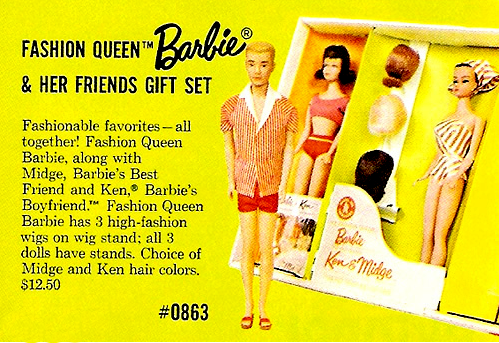Fashion Queen Barbie, 1963
In the late 1950's, the designers of the orignal Barbie doll had not anticipated the importance of hair play in the toy's conception. As a result, early Barbies had a stiff, fixed ponytail hairdo, which discouraged children from playing with or restyling the doll's hair.
Within a few years of Barbie's introduction, hairstyling would take on an important role in high fashion and popular culture (think Jackie-O). Competing hair play themed dolls in the early 1960s also pointed to Mattel's mistake. Always innovative, Mattel would strike back in late 1963 with the ultimate Barbie doll: Fashion Queen Barbie.
Glamorous, luxurious and expensive, Fashion Queen Barbie's distinctive feature was her molded hair that enabled her to wear wigs. Dressed in an eye catching gold and white striped swimsuit and matching turban, the doll was accompanied by 3 stylish wigs: a platinum bouffant, a brunette pageboy, and an auburn flip.
Fashion Queen Barbie was packaged in a large, open front display box, a style normally reserved for gift sets. Her release coincided with an intensive advertising campaign, meaning that despite her $6.00 selling price (twice that of a normal Barbie), she quickly became a must have with children. Two gift sets were also produced, featuring the Fashion Queen doll, accompanied by her best friend Midge, and boyfriend Ken.
Within a few years of Barbie's introduction, hairstyling would take on an important role in high fashion and popular culture (think Jackie-O). Competing hair play themed dolls in the early 1960s also pointed to Mattel's mistake. Always innovative, Mattel would strike back in late 1963 with the ultimate Barbie doll: Fashion Queen Barbie.
Glamorous, luxurious and expensive, Fashion Queen Barbie's distinctive feature was her molded hair that enabled her to wear wigs. Dressed in an eye catching gold and white striped swimsuit and matching turban, the doll was accompanied by 3 stylish wigs: a platinum bouffant, a brunette pageboy, and an auburn flip.
Fashion Queen Barbie was packaged in a large, open front display box, a style normally reserved for gift sets. Her release coincided with an intensive advertising campaign, meaning that despite her $6.00 selling price (twice that of a normal Barbie), she quickly became a must have with children. Two gift sets were also produced, featuring the Fashion Queen doll, accompanied by her best friend Midge, and boyfriend Ken.
Labels: Barbie, delightful dolls, kiddie kaleidoscope, very stylish girls




5 Comments:
fabulous!
Who would have thought that such a simple marketing change would have such a large impact. What's also hard to imagine is paying $6.00 for a Barbie doll when today they are more like $20/doll :P
Are these hair pieces still available today
I had her. But she came in a blue suicase gorgeous clothes. One of my favorite dolls and my original GI Joe.
I had her. But she came in a blue suicase gorgeous clothes. One of my favorite dolls and my original GI Joe.
Post a Comment